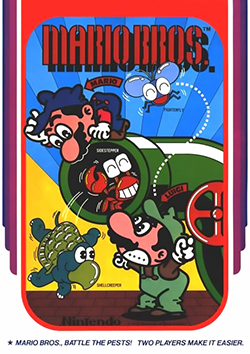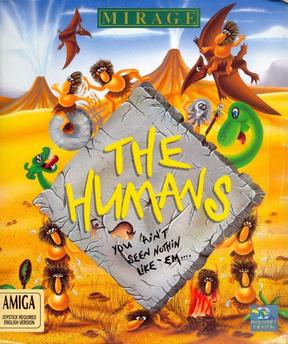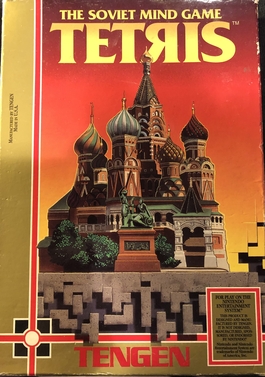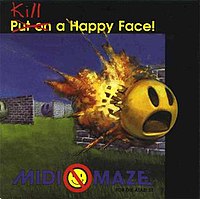
The Atari Lynx is a 16-bit fourth-generation hand-held game console released by Atari Corporation in September 1989 in North America and 1990 in Europe and Japan. It was the first handheld game console with a color liquid-crystal display. Powered by a 4 MHz 65C02 8-bit CPU and a custom 16-bit blitter, the Lynx was more advanced than Nintendo's monochrome Game Boy, released two months earlier. It also competed with Sega's Game Gear and NEC's TurboExpress, released the following year.

Mario Bros. is a platform game developed and published by Nintendo as an arcade video game in 1983. It was designed by Shigeru Miyamoto and Gunpei Yokoi, Nintendo's chief engineer. Italian twin brother plumbers Mario and Luigi exterminate creatures, like turtles (Koopas) and crabs emerging from the sewers by knocking them upside-down and kicking them away. The Famicom/Nintendo Entertainment System version is the first game produced by Intelligent Systems. It is part of the Mario franchise, but originally began as a spin-off from the Donkey Kong series.

Earthworm Jim is a 1994 run and gun platform game developed by Shiny Entertainment, featuring an earthworm named Jim, who wears a robotic suit and battles the forces of evil. The game was released for the Sega Genesis and Super Nintendo Entertainment System, before being subsequently ported to a number of other video game consoles.

Missile Command is a 1980 shoot 'em up arcade video game developed and published by Atari, Inc. and licensed to Sega for Japanese and European releases. It was designed by Dave Theurer, who also designed Atari's vector graphics game Tempest from the same year. The game was released during the Cold War, and the player uses a trackball to defend six cities from intercontinental ballistic missiles by launching anti-ballistic missiles from three bases.

BurgerTime, originally released as Hamburger in Japan, is a 1982 arcade video game from Data East released initially for its DECO Cassette System. The player is chef Peter Pepper, who must walk over hamburger ingredients in a maze of platforms and ladders while avoiding anthropomorphic hot dogs, fried eggs, and pickles which are in pursuit.

Ms. Pac-Man is a 1982 maze arcade video game developed by General Computer Corporation and published by Midway. It is a spin-off sequel to Pac-Man (1980) and the first entry in the series to not be made by Namco. Controlling the title character, Pac-Man's wife, the player is tasked with eating all of the pellets in an enclosed maze while avoiding four colored ghosts. Eating the larger "power pellets" lets the player eat the ghosts, who turn blue and flee.

Dig Dug is a maze arcade video game released by Namco in 1982. It was distributed in North America by Atari, Inc. The player digs underground tunnels to attack enemies in each level, by either inflating them to bursting or crushing them underneath rocks.

The Humans is a puzzle-platform video game developed by Imagitec Design in Dewsbury, England and originally published by Mirage Technologies for the Amiga in May 1992. It was later ported to other home computers and consoles. The goal of the game varies per level but usually revolves around bringing at least one of the player-controlled humans to the designated end area marked by a colored tile. Doing this requires players taking advantage of the tribe's ability to build a human ladder and use tools such as spears, torches, wheels, ropes and a witch doctor in later levels.

Wordtris is a Tetris offshoot designed by Sergei Utkin, Vyacheslav Tsoy and Armen Sarkissian and published by Spectrum HoloByte in 1991 for MS-DOS compatible operating systems. A port to the Game Boy, by Realtime Associates, and Super Nintendo Entertainment System were released in 1992.
Homebrew, when applied to video games, refers to software produced by hobbyists for proprietary video game consoles which are not intended to be user-programmable. The official documentation is often only available to licensed developers, and these systems may use storage formats that make distribution difficult, such as ROM cartridges or encrypted CD-ROMs. Many consoles have hardware restrictions to prevent unauthorized development.

Bases Loaded is a baseball video game by Jaleco that was originally released for the Nintendo Entertainment System. It was first released in 1987 in Japan and in 1988 in North America, and a Game Boy port was released in July of 1990. A mobile phone version exists as well. For the Virtual Console, Bases Loaded was released on September 11, 2007, in Japan and on April 7, 2008, in North America for the Wii, at the cost of 500 Wii Points and on May 15, 2013, in Japan and on July 10, 2014, in North America for Nintendo 3DS. The Wii U version in North America was also released at the same time as the Nintendo 3DS version. A port by Mebius and Clarice Games for the PlayStation 4 was released in Japan in 2015.

Tetris is a puzzle game developed by Atari Games and originally released for arcades in 1988. Based on Alexey Pajitnov's Tetris, Atari Games' version features the same gameplay as the computer editions of the game, as players must stack differently shaped falling blocks to form and eliminate horizontal lines from the playing field. The game features several difficulty levels and two-player simultaneous play.
The Virtual Console is a defunct line of downloadable video games for Nintendo's Wii and Wii U home video game consoles and the Nintendo 3DS family of systems.

Vortex is a 3D shooter game developed by Argonaut Software and released by Electro Brain for the Super Nintendo Entertainment System in September 1994. Titled Citadel during development, it is one of a few games designed to use the enhanced graphics of the Super FX powered GSU-1.

Lock 'n' Chase (ロック・ン・チェイス) is a maze chase video game developed by Data East and released in arcades in Japan in 1981. It was licensed to Taito for distribution in North America. It has similarities to Pac-Man, including a goal of collecting dots, with the addition of doors that periodically block pathways. Home versions for the Intellivision and Atari 2600 were published by Mattel in 1982 and an Apple II version appeared in January 1983.

A ROM cartridge, usually referred to in context simply as a cartridge, cart, or card, is a replaceable part designed to be connected to a consumer electronics device such as a home computer, video game console or, to a lesser extent, electronic musical instruments.

In video games, first-person is any graphical perspective rendered from the viewpoint of the player character, or from the inside of a device or vehicle controlled by the player character. It is one of two perspectives used in the vast majority of video games, with the other being third-person, the graphical perspective from outside of any character ; some games such as interactive fiction do not belong to either format.
Nintendo 64 accessories are first-party Nintendo hardware—and third-party hardware, licensed and unlicensed. Nintendo's first-party accessories are mainly transformative system expansions: the 64DD Internet multimedia platform, with a floppy drive, video capture and editor, game building setup, web browser, and online service; the controller plus its own expansions for storage and rumble feedback; and the RAM-boosting Expansion Pak for big improvements in graphics and gameplay. Third-party accessories include the essential game developer tools built by SGI and SN Systems on Nintendo's behalf, an unlicensed SharkWire online service, and unlicensed cheaper counterparts to first-party items. In the fifth generation of video game consoles, the Nintendo 64 had a market lifespan from 1996 to 2002.

Wayout is a 3D first-person perspective video game programmed by Paul Allen Edelstein and published for the Atari 8-bit computers in 1982. It was released for the Apple II and Commodore 64 in 1983. Wayout is among the first maze games to offer full 360 degree 3D perspective and movement, and its graphics were considered state-of-the-art upon its release. There were many pseudo-3D maze games at the time, but they used a fixed perspective and limited the player to four orientations.

Capture the Flag is a 3D first-person perspective, two player, video game, released for the Atari 8-bit computers and VIC-20 by Sirius Software in 1983. It was written by Paul Allen Edelstein as the follow-up to his 1982 game, Wayout, which has similar maze-based gameplay for one player. Along with its predecessor, Capture the Flag was among the first 3D maze games to offer the player full 360 degree movement, and one of the earliest multiplayer games from a first-person perspective within a 3D rendered environment.

















